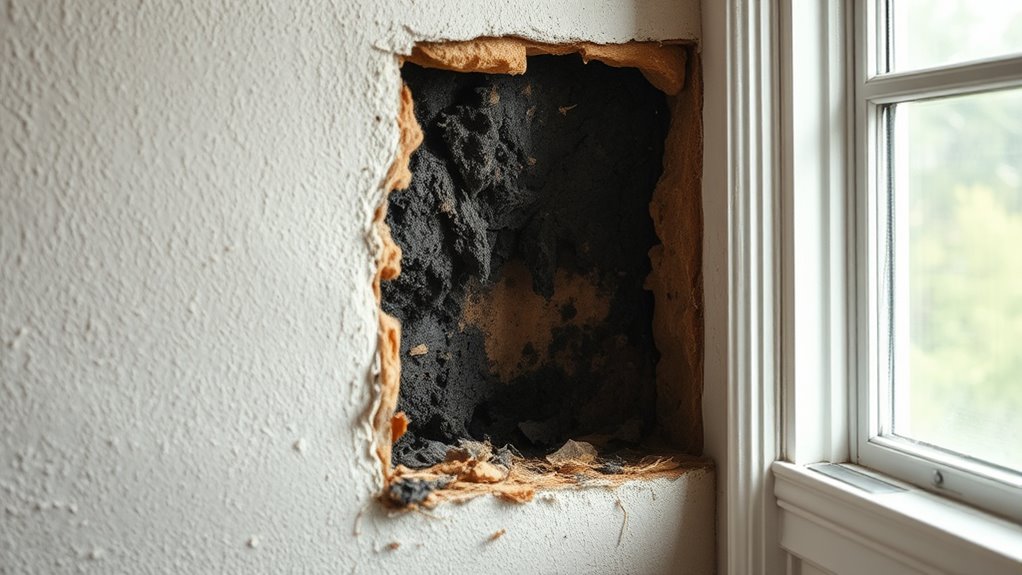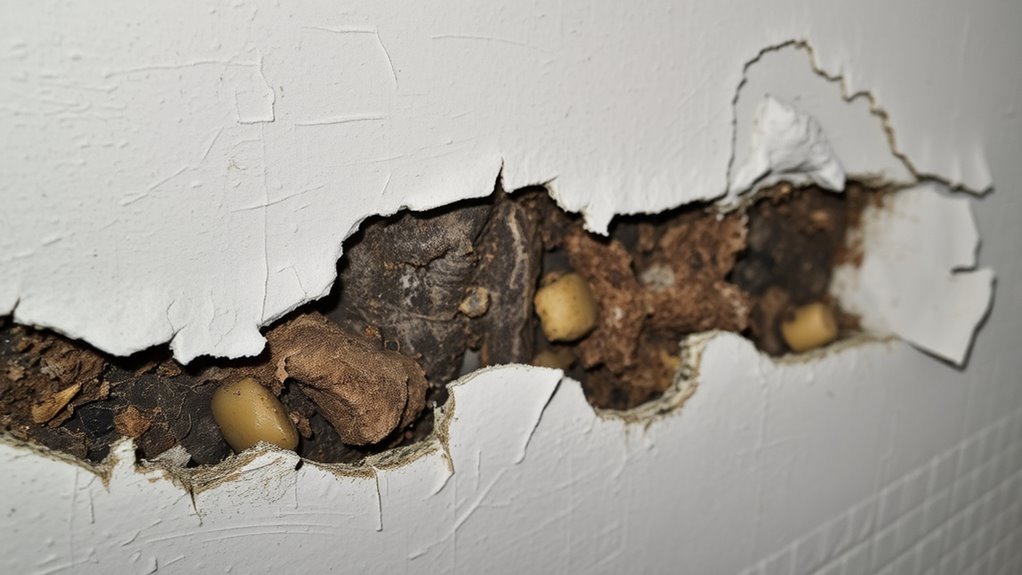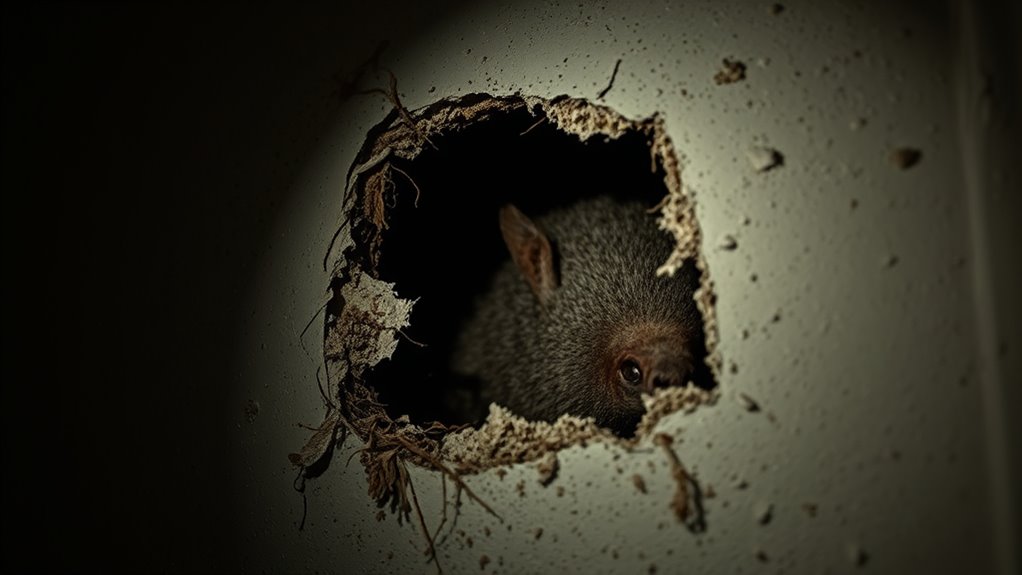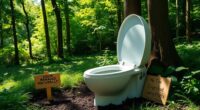If you notice a foul smell in your walls, it’s likely caused by a dead animal hiding inside. To tackle this, ventilate the area and carefully inspect vents, walls, and hidden spaces, using tools like flashlights or infrared cameras. Wear gloves and masks to stay safe during removal. Once you locate the carcass, remove it with tools and disinfect the area thoroughly. Continuing your efforts will help you eliminate the odor completely and prevent future issues.
Key Takeaways
- Ventilate the area thoroughly and inspect wall cavities with a flashlight to locate the source of the odor safely.
- Use tools like tongs or shovels to carefully remove the carcass and place it in sealed bags for proper disposal.
- Disinfect the affected area completely to eliminate bacteria and prevent persistent odors.
- Seal cracks and entry points around pipes and vents to prevent future animal intrusions.
- Seek professional help if the odor persists or if there is structural damage or mold present.
Identifying the Signs of a Dead Animal in Your Walls

If you notice a persistent, foul odor lingering in your home, it could be a sign of a dead animal trapped inside your walls. You might also see small pests like flies or maggots near wall vents or along baseboards, indicating decomposition nearby. Unexplained stains or discoloration on your walls and ceilings can point to a carcass behind the surface. Sometimes, you’ll hear faint scratching, squeaking, or thumping sounds within the walls, especially at night. If your air feels heavy or stuffy despite ventilation, it could be due to decay emitting foul gases. Be alert to any sudden, strong odors that seem to intensify over time. Recognizing these signs early helps you determine if there’s an animal carcass behind your walls, prompting further action. Additionally, understanding automated detection methods can assist professionals in locating and removing concealed carcasses more efficiently.
Safe Steps to Locate the Source of the Odor

Locating the source of a dead animal odor requires a careful and systematic approach to guarantee safety and accuracy. Start by ventilating the area to disperse airborne bacteria and odor. Use a flashlight to inspect wall cavities, vents, and hidden spaces for any signs of carcasses or droppings. Wear gloves and a mask to protect yourself from potential pathogens. To help pinpoint the smell, consider using a moisture meter or infrared camera, which can detect temperature variations caused by decomposing tissue. Additionally, employing automation’s role in detection tools can enhance the accuracy and efficiency of your inspection process. Here’s a quick guide:
| Step | Action |
|---|---|
| 1 | Ventilate the area thoroughly |
| 2 | Inspect accessible wall spaces |
| 3 | Use protective gear |
| 4 | Employ detection tools (infrared) |
| 5 | Mark suspicious spots for further inspection |
Removing the Dead Animal and Cleaning the Area

Once you’ve identified the dead animal’s location, the next step is to carefully remove the carcass and thoroughly clean the surrounding area. Handling the carcass with gloves and a mask is essential to avoid exposure to bacteria and odors. Proper disposal methods are crucial to prevent further contamination or odor issues. Follow these steps:
- Use tools such as tongs or a shovel to carefully lift and remove the animal, placing it in a sealed plastic bag for disposal.
- Clean the area with a disinfectant solution to eliminate bacteria and prevent odor spread.
- Ventilate the space by opening windows and using fans to help dissipate lingering smells and air out the area. Effective ventilation is vital for reducing odors quickly and safely.
Preventing Future Incidents and Odor Recurrence

To prevent future incidents and odor recurrence, it’s important to establish proactive measures that discourage animals from entering your walls. Seal any cracks, gaps, or holes around pipes, vents, and foundations using durable materials like steel wool or caulk. Installing barriers or screens can also prevent entry points. Regularly inspect your property for new openings and address them promptly. Consider trimming trees or shrubbery near your home to reduce animal access. Incorporating offensive security measures into your property maintenance can further enhance your defenses against unwanted intruders.
When to Seek Professional Assistance

You should consider seeking professional assistance when the odor persists despite your efforts to eliminate it or if you notice signs of structural damage caused by the animal’s presence. Ignoring these signs can lead to health hazards or further property damage. Additionally, professionals can help identify and address any underlying issues related to privacy policies and ensure that your home remains safe and compliant with relevant regulations. Here are three indicators that it’s time to call in experts:
- The smell remains strong after thorough cleaning and deodorizing.
- You see evidence of structural issues, such as warped walls or floorings.
- There’s visible damage or signs of mold and decay around the affected area.
Professionals have the tools and experience to locate hidden carcasses, properly remove them, and repair damage. Acting promptly ensures your safety and prevents costly repairs down the line.
Frequently Asked Questions
How Long Does the Smell of a Dead Animal Typically Last?
You’re wondering how long a dead animal smell typically lasts. It usually persists for a few days to a week, but it can linger longer if the carcass isn’t removed or if it’s in a hard-to-reach wall. To speed up the process, you should locate and remove the carcass, ventilate the area, and use odor absorbers like activated charcoal or enzyme cleaners. Acting quickly helps eliminate the smell faster.
Can Dead Animals in Walls Pose Health Risks?
Dead animals in walls can pose health risks because they attract bacteria, mold, and pests like flies or rodents. These contaminants can cause allergic reactions, respiratory issues, or infections if you come into contact with them or breathe in airborne particles. It’s essential to address the problem promptly by removing the animal and thoroughly cleaning the area. If you notice symptoms or persistent odors, consider consulting a professional for safe removal and sanitation.
Are There DIY Methods to Neutralize the Odor Effectively?
Imagine trying to clear fog from a window—ventilation alone often isn’t enough. You can try DIY methods like placing bowls of white vinegar or baking soda around your walls to absorb odors. Activated charcoal also helps. While these can reduce smells temporarily, for deep-seated odors, professional removal is best. Think of it as trying to wipe away a stain—sometimes, you need stronger tools to get it fully out.
What Types of Animals Are Most Commonly Found Dead in Walls?
You probably want to know which animals are most commonly found dead in walls. Typically, small animals like mice, rats, squirrels, and raccoons enter homes and sometimes get trapped or die inside the walls. Their carcasses often cause unpleasant odors. You should inspect your walls carefully, especially near entry points or attic spaces, and consider professional help if you find or suspect an animal inside.
How Can I Prevent Animals From Entering My Walls in the Future?
Preventing pests from penetrating your property starts with simple steps. Seal small cracks and crevices, close gaps around pipes, vents, and windows, and install barriers like chimney caps. Keep your home clean and clutter-free, reducing attractive hiding spots. Regularly inspect walls and foundations, and trim tree limbs away from your roof. By maintaining these measures, you make your home less appealing and less accessible to unwelcome wildlife seeking shelter.
Conclusion
So, you’ve mastered the art of sniffing out dead animal odors and playing detective in your own walls. Congrats! Just remember, if your DIY efforts turn your home into a stinky museum of misguided attempts, it might be time to call in the pros—because some mysteries are better left to those with proper tools and a sense of smell. After all, nobody wants their house to double as a mausoleum, right?









